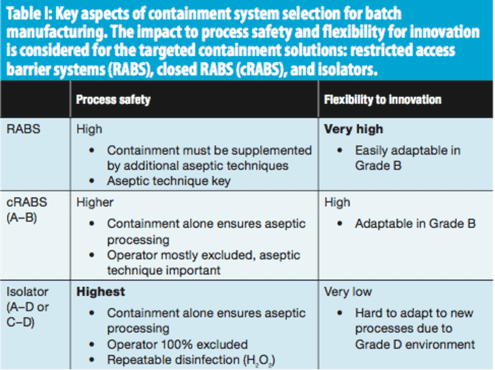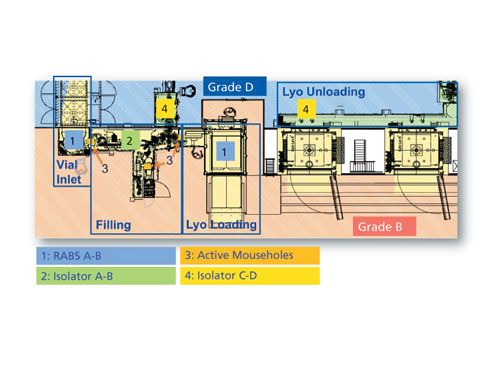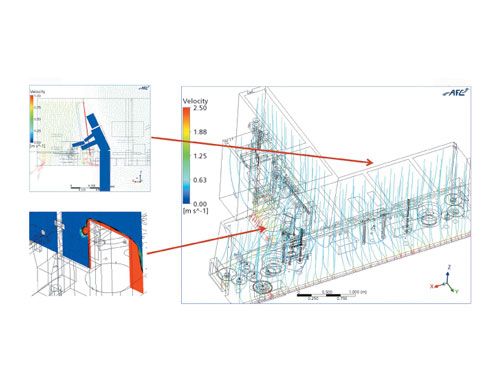Designing Flexible Aseptic Containment Systems
Equipment and Processing Report
The design of Baxter BioPharma Solutions’ aseptic filling lines provides a case study in customizing containment systems for multi-product lines
Containment systems have to be customized to accommodate the specific needs and requirements of multi-product lines. The design and development of containment within a new facility constructed at Baxter BioPharma Solutions’ contract manufacturing site in Halle/Westphalia, Germany is an example of such customization. At this facility, consideration of aseptic processing and safety standards for the production of oncology drugs, combined with a need for flexibility, led to a design that incorporates both isolator and restricted access barrier system (RABS) architecture.
Containment solutions
There are three main categories of process equipment containment systems:
- RABS (open RABS)
- cRABS (closed RABS)
- Isolator.
Containment needs to be adapted to the process requirements. Isolators are often the best solution, but there are exceptions. Each type of containment system must meet certain requirements for the surrounding environment and specific characteristics with regard to process safety and flexibility for innovation, as shown in Table I.

There are two different properties that need to be balanced for each application: separation and flexibility. The higher the separation of the inner and outer site of containment, the less flexibility the system can provide.
An open RABS with standard laminar airflow that drains air to the outer environment provides a high degree of accessibility to the process. However, separation of the containment towards the outer environment is not complete. Air flows from inside the containment system continuously to the outer environment. This directed flow acts like a barrier (e.g., to any particle contamination) and thus provides a high level of protection to the product. The air is also a possible route of contamination for the operators, however, especially when manufacturing highly potent drugs.
A closed RABS (cRABS) provides containment with a fully closed air flow system. However, automatic sterilization features, such as vaporized hydrogen peroxide (VHP) generators or Skanfog Systems, are typically not included. As long as the cRABS remains closed, the level of protection is higher compared to the open RABS.
The containment of an isolator remains locked once the mandatory sterilization step, for instance with VHP, is performed. This requirement provides the highest level of protection for product and personnel. Access to the process can only be gained through glove and port systems. This demand requires a conscious design of the isolator that considers all possible interventions in advance. Gloves and ports can be placed in an optimized way, but will have certain restrictions due to geometry of the containment components.
Thus, for every containment design, it is important to consider the appropriate need and impact of the degree of separation. These considerations will be governed by aseptic requirements of the process, accessibility, safety, and the architecture of the outer environment.
Design of the new lines
The new facility in Halle contains two filling lines with connected compounding areas that can either output filled vials with liquid product or feed them into freeze dryers. Both lines are designed for oncology products, and they apply the same design and process principles. The lines differ, however, with regards to size, throughput, and degree of flexibility. Although the large-scale production line has a higher throughput and larger capacity freeze dryers, the small-scale line allows for more flexibility in the compounding area.
Project considerations. The key driver for the project was to use leading edge, yet reliable, technology that would provide the flexibility and speed needed to meet the demand for contract manufacturing of oncology products in emerging market niches. The core technology is the filling of liquid solutions into different vial formats, typically with a subsequent freeze-drying process.
General considerations to meet these requirements were identified as follows:
- Applying the “form follows function” concept to support the aseptic process
- Process standardization and risk analysis as valuable tools for preparing the URS (user requirement specification)
- Process visualization to reduce variation and ensure product quality
- Flexibility as a key aspect for process design to ensure processing of a broad variety of different products and ensure maximum operational availability.
These requirements, especially with respect to the design of the containment systems, further present the following challenges:
- Usage for different highly active products (i.e., cleanable)
- Fulfillment of safety standards for handling cytotoxic substances
- Flexibility of the filling line configuration to accommodate different setups (e.g., filter combinations, filling technology, solution transfer from disposable bags)
- Production including cleaning, sanitization, and turnaround within one day.
Another important aspect for the design of the containment system was to establish a consistent structure and appearance throughout the complete line. Besides the mechanical appearance of the different compartments of the containment, the handling and automation interfaces are aligned so that, in all areas, the containment system offers the same look and feel, providing operators a standard interface throughout the process.
The decision to use a modular approach for the design of the new manufacturing building was made based on the extension strategy. The capacity of the building can be doubled without interruption of the manufacturing operation
Containment design. For the containment, the challenge was to maximize process flexibility while adhering to the standards for handling cytotoxic and highly potent substances. Additionally, the requirement for daily product changeovers necessitated a cleanable architecture of the containment. This requirement led to a flexible design, as shown in Figure 1, which applied isolator technology to the aseptically and toxically critical process steps, specifically the filling process in a class A environment (e.g., aerosols during filling, potential breakage of vials) and the unloading process in a class C environment with class A air supply (e.g., powder of lyophilized product if vials break). The filling isolator is equipped with active mouse holes (i.e., transitions between the containment system parts), which use a separate air supply and exhaust to effectively prevent airflow across the mouse holes. This requirement is particularly important to protect the aseptic core and provide safety to the operating personnel.
Figure 1. Combining isolators and restricted access barrier systems (RABS) results in a flexible process design. The sketch of the production line shows the containment solution by area. All figures are courtesy of the authors.

To maximize flexibility, the class A containment is placed in a class B background environment with directional (ceiling to floor) airflow. Isolators in the class B environment ensure product and EHS safety while maintaining flexibility for multi-product manufacturing
Additionally, Skanfog technology was applied in the design of the isolators to enhance the sterility assurance level for aseptic manufacturing. This technology uses the following principle: hydrogen peroxide solution, with the help of compressed air and special nozzles, is distributed homogeneously with a very small droplet size at a given total amount inside the isolator. A time-controlled step ensures the effectiveness of this process, which is validated for the standard loading of the isolator during preparation.
This design allows the filling isolator to be run in two modes:
- Classic isolator mode with a standardized decontamination cycle (Skanfog) and 100% separation of process and personnel (i.e., doors always closed). This mode is applicable for standardized processes and high volume manufacturing.
- cRABS mode where special process requirements can be integrated immediately into the validated setup of the isolator (i.e., stirring steps for the filling of disperse systems, or special filtration steps for products sensitive to high temperature or shear force). Even processing of containers made from polymers can be performed in the cRABS mode. The decontamination cycle is still run routinely for additional process safety.
Furthermore, the processes for filling, cleaning, and decontamination are highly standardized by computer-controlled process flows. The filling lines have a unique design to avoid the necessity of equipment for cleaning in place (CIP) and sterilization in place (SIP). Avoidance of the complex CIP/SIP process allows rapid turnover by maintaining the high sterility assurance level of an isolator. At critical process steps, the user is guided by the automated system, ensuring execution of all necessary actions in the correct order in the closed containment system, whereas in all other process steps, maximum flexibility of the system is allowed.
Modeling as a design tool. The engineering team used intensive application of computational fluid dynamics (CFD) to gain insights on airflow behavior during the mechanical design of the containment system. An example is shown in Figure 2. These insights were used to drive the design from an aerodynamic perspective (e.g., readjust air return ducts). Based on (simplified) three dimensional (3D) layouts, airflow patterns were determined and compared with the desired behavior. In the design phase of the heating, ventilation, and air conditioning (HVAC) and process equipment, this predictive modeling enabled the engineering team to evaluate potential influences and adjust design measures. The airflow patterns derived by CFD during the design phase were reproduced by smoke studies during the qualification phase.
Figure 2: Simulation of critical interventions with computational fluid dynamics. The layout on the right hand side shows the streamlines of the laminar flow, the images on the left hand side show a critical intervention close to the filling station (above) and simulation of the stopper bowl, including particle distribution upon creation of a particle source (below); red=high concentration; blue=low concentration.

Integrating conventional construction with 3D technology enabled construction of the manufacturing areas concurrently with the conventionally constructed portions of the building and equipment, saving months on the overall project timeline.
Glass structures for visibility. Another key aspect during facility design was the integration of glass elements wherever possible (e.g., cleanroom walls, windows on all sides of the containment) to focus on transparency and visibility. Lean manufacturing principles combined with 3D design principles resulted in a facility made largely out of glass (>60%), where infrastructure design is optimized for processes in a “form follows function” concept. Clear structure and visibility down to the inner aseptic core of the facility supports the processes. Natural light has a positive influence on operator performance in the aseptic core area, and the high visibility of the manufacturing processes leads to an increase in discipline in the manufacturing team.
Automated operator guidance. Project management resources were focused in the early stages on automated operator guidance for critical-to-quality steps of the process, such as decontamination and cleaning. Thus, automated machine interfaces could be harmonized and standardized throughout the process from filling through loading/unloading. This automation provides operators a standard interface throughout the entire process.
Qualification and validation
From the beginning, a key focus was to keep the design of both lines as similar as possible. Because most of the risks were the same to both lines, the same architecture, instrumentation, and parts were applied to both lines during design qualification. Additionally, insights from CFD simulation were applied to both lines and documented in the design qualification.
Moving forward, risk analysis and design qualification led to similar installation qualification and operational qualification tests for each line, which could be executed almost in parallel. This parallel execution led to benefits in work organization and safety due to double-checking of design principles and processes on both systems.
Crucial actions in critical process steps (e.g., decontamination, cleaning) are controlled by qualified program sequences, ensuring a high level of standardization of critical process steps. In other process steps, this program-controlled operator guidance does not exist to allow flexibility to adapt to different requirements for production or preparation.
Operational excellence
In-house experience and a thorough understanding of each project phase/qualification allowed Baxter to execute the expansion with minimal reliance on external consultants. Design project teams transitioned to routine manufacturing, retaining knowledge and experience throughout the project phases. Modular design allows for future line expansions and enabled the doubling of lyophilization capacity without shutdown of manufacturing, helping to ensure a continuous supply of drug product to customers. The innovative manufacturing concept applied state-of-the-art containment technology, combined with high flexibility for rapid changeover and broad flexibility, to manufacture a wide variety of liquid formulations (e.g., organic solvents, biologics, suspensions). This combination helps to ensure economical manufacturing and quality product.
In recognition of these achievements, Baxter’s Halle, Germany facility received a 2016 Facility of the Year Award (FOYA) in the category of Operational Excellence from the International Society for Pharmaceutical Engineering.
About the authors
Frank Generotzky is Plant Manager and Martin Tuckermann, PhD, is Project Manager, both at Baxter BioPharma Solutions, Kantstrasse 233790 Halle, Germany, Tel: +49.5201.711.0, biopharmasolutions@baxter.com.
Article DetailsPharmaceutical Technology
Vol. 40, No. 8
Pages: 58–61
Citation:
When referring to this article, please cite it as F. Generotzky and M. Tuckermann, "Designing Flexible Aseptic Containment Systems," Pharmaceutical Technology 40 (8) 2016.
Drug Solutions Podcast: A Closer Look at mRNA in Oncology and Vaccines
April 30th 2024In this episode fo the Drug Solutions Podcast, etherna’s vice-president of Technology and Innovation, Stefaan De Koker, discusses the merits and challenges of using mRNA as the foundation for therapeutics in oncology as well as for vaccines.
Drug Solutions Podcast: Gliding Through the Ins and Outs of the Pharma Supply Chain
November 14th 2023In this episode of the Drug Solutions podcast, Jill Murphy, former editor, speaks with Bourji Mourad, partnership director at ThermoSafe, about the supply chain in the pharmaceutical industry, specifically related to packaging, pharma air freight, and the pressure on suppliers with post-COVID-19 changes on delivery.
Pharmaceutical Tariffs Are Imminent: How Industry is Bracing for Impact
April 16th 2025On April 14, 2025, the Trump Administration launched a national security-driven investigation into pharmaceuticals, a move that will likely result in tariffs being placed on pharmaceutical drugs, ingredients, and other components that are imported from outside of the United States.
